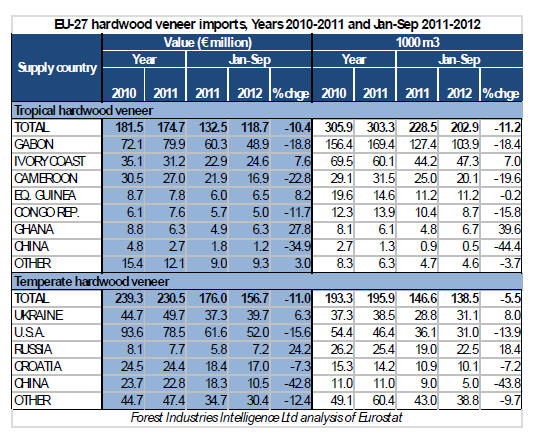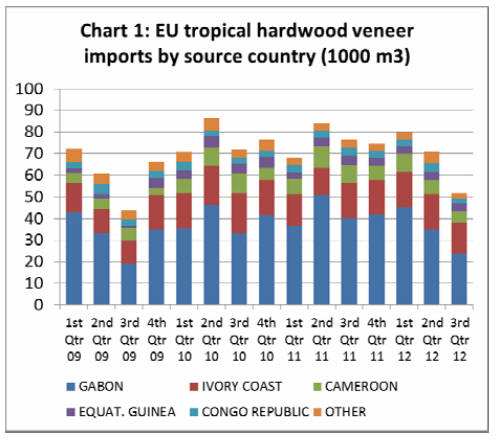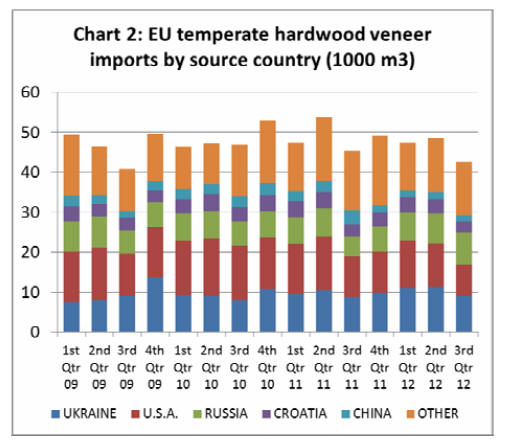|
Report
from
Europe
Slight signs of rising optimism
Prospects for the European economy seem more positive now than this time
last year. The worst fears of a destructive domino effect that might
have resulted from Greece or another country being forced out of the
euro-zone have failed to materialise. The effects of the financial
crises were largely contained within the most afflicted economies of
southern Europe.
The countries of central and north-western Europe, while experiencing
higher than normal levels of economic volatility, have so far managed to
weather the storm. Their relative stability has prevented the effects of
the financial crises from spreading throughout Europe.
In recent months, several economic indicators in the EU, such as the
Economic Sentiment Indicator and the Construction Confidence Index, have
improved. There is cautious optimism that economic reforms in the most
troubled EU countries are beginning to work.
But while confidence has risen, it is starting only from a very
depressed level and remains well below pre-recessionary levels. Many
serious underlying constraints to market growth remain. Financing and
credit are still tight. Companies remain highly risk aversive.
Activity in the construction sector remains very slow and may even
decline further this year. Latest data for the Eurostat building permits
index - a key forward indicator of likely future levels of construction
- has yet to show any sign that the market has turned a corner.
Fourth quarter 2012 GDP data for the large euro-zone economies - France,
Germany, Italy, and Spain - has yet to be published, but economists are
already pencilling in likely declines across the board. After a bouyant
3rd quarter of 2012, the UK economy shrank again (by 0.1%) in the last
quarter of the year.
Mario Draghi, president of the European Central Bank, was gloomy in his
comments to the media on 7 February, suggesting that economic risk
remains skewed to the downside and that there is likely to be further
weakness in 2013.
Short-term increase in tropical hardwood imports
Nevertheless, several factors have encouraged a slight increase in
European imports of tropical hardwood products during the opening weeks
of 2013. The euro exchange rate has strengthened, hitting $1.3657 in
mid-February, its highest level since November 2011.
This trend has generally reduced the costs of imports. At the same time,
European stocks of tropical wood products were very low at the start of
the year following low import volumes in the second half of 2012.
Another factor is the imminent enforcement of the EU Timber Regulation
on 3 March 2013. After that date, European importers will be liable for
prosecution if the European authorities are able to demonstrate that the
wood is from an illegal source, or that the importer has failed to
implement due diligence procedures in line with the regulatory
requirements.
This last factor has encouraged some European tropical wood importers to
take steps to rebuild stocks earlier rather than later.
Unfortunately all these factors are likely to be short-lived and few in
the European tropical wood importing industry are expecting any
significant upturn in real consumption during 2013.
Decline in EU hardwood veneer market
In the first 9 months of 2012, the EU imported 203,000m3 of tropical
hardwood veneer with a value of €119 million, down 11% and 10%
respectively compared to the same period in 2011 (Table).
Imports from Gabon, Cameroon and the Congo Republic were declining in
2012, while imports from Ivory Coast, Equatorial Guinea and Ghana were
stronger than in 2011.
The quarterly data (Chart 1) reveals that there was a particularly
dramatic fall in tropical hardwood veneer imports from Gabon in the 3rd
quarter of 2012.

The decline in imports is not confined to tropical hardwood veneer. EU
imports of temperate hardwood veneer were 138,500 m3 with a value of
€157 million in the first nine months of 2012, down 6% and 11%
respectively compared to the same period in 2011.
Imports of this commodity fell sharply from the USA and China in 2012,
but were rising from Ukraine and Russia. As for tropical hardwood
veneer, the quarterly data indicates that imports of temperate hardwood
veneer were particularly weak in the third quarter of 2012 (Chart 2).
Falling veneer imports is a symptom of long term weakness in the
European plywood and veneer industries. European manufacturing of
tropical hardwood plywood has been declining under pressure from weak
construction sector growth in the key markets of France, Netherlands,
Italy and Spain.
Okoume plywood manufactured in the EU is also struggling to compete
against cheaper imported plywood, particularly from China, and
alternative panel products.
As a result the fall in okoume log imports following the Gabon log
export ban in May 2010 has not been offset by any increase in rotary
veneer imports.


The European market for decorative sliced veneers is also suffering.
According to the German trade journal EUWID, European domestic
manufacturers of this product were only operating at around 60% capacity
during 2012.
There was a short-lived upturn in the European market for decorative
sliced veneer in the first quarter of 2012 after a poor year in 2011.
However this recovery failed to gain traction and demand slowed again in
April/May 2012.
A major factor contributing to the slowdown in European decorative
sliced veneer market was a decline in orders by furniture manufacturers,
notably IKEA which plays a critical role in the market. At the end of
2012, EUWID reported that IKEA is planning to slash veneer orders over
the next two years and that the furniture giant may halve its use of
veneer by 2014.
Demand from furniture companies other than IKEA also fell dramatically
during the second half of 2012.
Demand from the European door sector was weakening. The only industrial
sector EUWID reckons was performing reasonably well during 2012 was the
high-end market for veneer in car interiors.
With Europe’s industrial markets for sliced veneer seemingly in
long-term decline, European manufacturers and traders are selling more
veneer products for bespoke joinery and interior remodelling projects.
According to the 2012 GD Holz survey of the German veneer trade, this
sector accounts for 42% of all veneer sold by the 39 veneer mills and
veneer traders located in Germany.
Only around 34% of sales volume is now destined for industrial users
(including doors, furniture, flooring, and board producers). This
compares to a figure of 47% only three years ago.
The GD Holz survey also provides an insight into species preferences in
the German veneer sector. Species usage by surveyed companies in 2012
was as follows: European oak (22%), tropical hardwood (16%), European
maple (10%), European beech (9%), European ash (6%), American white oak
(9%), American walnut (8%), American hard maple (4%), American cherry
(3%), and others (13%).
Niche markets for tropical wood in Spain
In the years up to 2007, Spain was one of Europe's largest markets for
tropical hardwood products. However Spain's hardwood consumption has
nose-dived since then following the very sharp decline in construction
activity and weak domestic and export demand for Spanish furniture.
Nevertheless, hardwood continues to be consumed in Spain, with much
demand now driven by renovation and refurbishment in the building sector
and by exports of the larger joinery and furniture manufacturers.
A recent survey of Spanish hardwood importers by the Spanish Timber
Importers Association (AEIM) with support from the American Hardwood
Export Council (AHEC) highlights where different types of hardwood
continue to be used.
The AEIM/AHEC survey shows that tropical species account for nearly all
the hardwood used by Spanish windows manufacturers. Iroko alone accounts
for two thirds of all hardwood consumed in this sector, with the
remainder mainly comprising a mix of African and Brazilian species.
Naturally durable tropical species, mostly from Brazil, still account
for around 97% of the Spanish wood decking market, although there is a
small but growing demand for heat-treated ash which is being adopted now
for both technical and environmental reasons.
Tropical wood is less widely used in the interior joinery sector,
although it still occupies some important niche markets. Around 45% of
the hardwood used for stair components in Spain comprises tropical wood,
mostly from Brazil and Africa. Much of the rest of this market is served
by American white oak, European oak and beech.
Oak, including both U.S. white oak and European oak, is also the leading
hardwood consumed in Spain's flooring sector. But the survey also shows
that darker tropical species sell better than oak in northern Spain
where traditionally there has been a strong market for solid hardwood
flooring.
In the interior doors sector, formerly a large consumer of hardwood
lumber and veneer in Spain but now much diminished, tropical wood
species account for around one third of hardwood usage.
The dominant hardwood species in this sector is American white oak, but
sapele and a range of Brazilian species continue to be used by the
surviving manufacturers.
Tropical timbers - notably iroko - are also used for shop-fitting in
Spain and account for around a quarter of all hardwood used in this
sector. The main temperate hardwoods used in this sector are European
beech and oak, with smaller volumes of US white oak.
Tropical species contribute only a relatively small proportion of
hardwood used in the Spanish interior furniture sector. About 15% of
hardwood used to manufacture classic furniture in Spain is tropical,
nearly all from Africa.
The modern furniture sector in Spain uses mainly beech and pine, but
about 10% is comprised of tropical wood, mainly a mix of African and
Brazilian species. Manufacturers of high class solid hardwood kitchens
typically use American white oak, European oak and beech, with tropical
wood accounting for around 8% of hardwoods used.
Environmental NGO highlights improvements in tropical forest
governance
Ten years on since the EU Forest Law Enforcement Governance and
Trade (FLEGT) Action Plan was launched, and one month before the
introduction of the EU Timber Regulation (EUTR) which makes it a
criminal offence to put illegally sourced timber on the EU market, new
research by FERN, an EU-based environmental NGO, has shown strong forest
governance improvements have already been achieved.
The FLEGT Action Plan, launched by the EU in 2003, includes the
development of voluntary partnership agreements (VPAs) with timber
producing countries. VPA negotiations have so far been concluded with
six timber producing countries: in chronological order, Ghana, the
Republic of Congo, Cameroon, the Central African Republic, Indonesia and
Liberia.
Six more VPAs are currently being negotiated. A key part of the VPA
process is development of procedures to ensure credible legality
licensing procedures for all timber exported by partner countries into
the EU.
FERN report that "international and national NGOs have been part of
their design, and have helped ensure VPAs include essential principles
of forest governance. FERN’s research shows these have been largely
respected....One of the most startling findings was that all the VPAs
concluded to date have been negotiated in a multi-stakeholder process
involving representatives from local human rights and environmental
organisations, the private sector and government. This is the first time
that legally binding trade agreements have been negotiated and agreed in
such an inclusive, consensus-based process. The process has therefore
been perceived as empowering local civil society actors".
FERN’s analysis has shown that every VPA concluded so far covers all
exports (not just those to the EU), and all timber products. With the
exception of the Central African Republic, all concluded VPAs also
include the domestic
market. FERN comment "this could have a large impact on local
communities in these timber-producing countries. Most VPAs also include
reforms concerning community forests, the domestic market, and to some
extent improved recognition of customary rights".
In their report, FERN emphasise the importance of successful
implementation of the EUTR in order to build on the work already done
through VPAs.
They suggest that "if this legislation is not effective in reducing
illegal timber imports, producer countries may lose interest in a VPA.....To
ensure the EUTR and the FLEGT VPAs become mutually supportive, the EU
and the Member States have to ensure a robust and effective
implementation of the EUTR across all Member States. If illegal timber
continues to be imported into the EU, the effectiveness of the VPAs will
be undermined.”
|